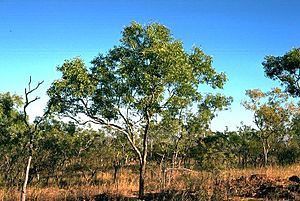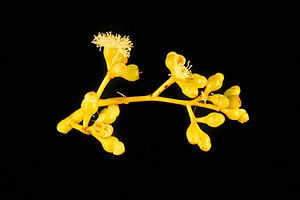Katherine box facts for kids
Quick facts for kids Katherine box |
|
|---|---|
 |
|
| Eucalyptus distans growing near Katherine | |
| Conservation status | |
| Scientific classification | |
| Genus: |
Eucalyptus
|
| Species: |
distans
|
| Synonyms | |
|
Eucalyptus epruinata L.A.S.Johnson & K.D.Hill |
|
The Katherine box (scientific name: Eucalyptus distans) is a type of small tree. It grows only in northern Australia. This tree has rough, grey bark that feels like fiber. Its leaves are dull and shaped like a spear. It also has flower buds that grow in groups of seven. When it blooms, it has creamy white flowers. After flowering, it produces fruit shaped like a cup or a cone.
What Does It Look Like?
The Katherine box tree usually grows to be about 7 to 9 meters (23 to 30 feet) tall. It has a special woody swelling at its base called a lignotuber. This helps the tree regrow if it gets damaged.
Its bark is rough, grey, and fibrous. It has small cracks and white patches. Young plants and new shoots (called coppice regrowth) have narrow, spear-shaped leaves. These leaves are about 11 to 14.5 centimeters (4.3 to 5.7 inches) long and 1 to 2 centimeters (0.4 to 0.8 inches) wide.
Adult leaves are dull, light green to grey-green on both sides. They are shaped like a spear or slightly curved. They measure about 5.5 to 15 centimeters (2.2 to 5.9 inches) long and 1.2 to 2.6 centimeters (0.5 to 1 inch) wide. These leaves grow on a stalk called a petiole, which is 0.5 to 2.3 centimeters (0.2 to 0.9 inches) long.
The flower buds grow in groups of seven. They are found where the leaves meet the stem (called the axil). Each group of buds is on a thin, branched stalk called a peduncle, which is 0.2 to 1 centimeter (0.08 to 0.4 inches) long. Each individual bud has a smaller stalk called a pedicel, up to 0.6 centimeters (0.2 inches) long.
Mature buds are shaped like a cylinder or an oval. They are about 0.3 to 0.4 centimeters (0.12 to 0.16 inches) long and 0.3 centimeters (0.12 inches) wide. They have a cone-shaped or rounded cap called an operculum.
The Katherine box blooms between March and April. Its flowers are creamy white. The fruit is a woody capsule (a dry fruit that opens to release seeds). It is shaped like a cup, hemisphere, or cone. The fruit is about 0.3 to 0.5 centimeters (0.12 to 0.2 inches) long and wide. It sits on a pedicel up to 0.6 centimeters (0.2 inches) long. The parts that open to release seeds (called valves) stick out past the rim of the fruit. The seeds inside are blackish-brown.
How It Got Its Name
The Katherine box was first officially described in 1980. This was done by three scientists: Ian Brooker, Douglas Boland, and David Kleinig. They studied samples collected near Katherine Gorge in 1977. Their description was published in a science journal called Australian Forest Research.
Another name, Eucalyptus epruinata, was described in 2000. However, it is now considered a synonym, meaning it's another name for the same plant.
The scientific name distans comes from a Latin word. It means "remote" or "far apart." This name was chosen because this species grows separately from a similar tree, E. microtheca.
Where Does It Grow?
The Katherine box grows on low, stony ridges. You can find scattered groups of these trees across the Northern Territory. They grow between Katherine and Gove. There are also separate groups (called disjunct populations) far away from the main group. These are found near Fitzroy Crossing in Western Australia and near Croydon in Queensland.
Is It Endangered?
The Government of Western Australia's Department of Parks and Wildlife lists Eucalyptus distans as "Priority One". This means it is known to grow in only a few places. These places might be at risk, so the tree needs special protection.



